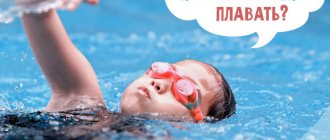Swimming is extremely beneficial for a child. After all, it strengthens the musculoskeletal system, develops motor skills and coordination of the child. And the sooner a child starts swimming, the better.
This is not a new fashion fad. Pediatricians recommend swimming lessons for babies as well as massages and gymnastics for young children. It is swimming that has a beneficial effect on improving the physical development of a child.
When children swim underwater, they experience skin massage. In addition, the baby has to resist the water in order to intuitively stay on the surface. Due to this, a kind of gymnastics and training of the musculoskeletal system occurs.
It is also useful for the child’s sweat glands, which are just starting to work normally. During bathing and swimming, they are washed, and the skin and internal organs are saturated with oxygen from the movement.
So, there are definitely benefits from swimming a newborn.
While bathing, the contrast between the temperature of the air and the water is constantly felt, the child is hardened. As a result, the baby suffers less often from colds and tolerates them more easily.
Water has a density greater than air, and for this reason, a child, swimming in it, must overcome the resistance of the environment, and this is a very good workout for the musculoskeletal system. Children who go swimming from the first weeks of life are able to develop faster and physically better; there is a high probability that they will begin to walk earlier than their peers.
Swimming helps strengthen the cardiovascular system.
How is swimming good for babies?
From birth, children are already able to swim: they can hold their breath under water and splash with pleasure in the bathtub. This is explained by innate reflexes - before birth, the baby in the mother’s stomach was in a liquid environment. Around three to four months, this innate reaction fades away, and the baby will have to learn to stay afloat much later.
However, the point of such activities with a newborn is not to make him a future Olympic champion. Increasingly, pediatricians are saying that infant swimming brings invaluable benefits .
- Regular water procedures teach children to be calm about temperature changes. Thanks to hardening, the immune system is strengthened, which reduces the likelihood of colds, promotes dynamic physical development and helps prevent a variety of health problems.
- The result of systematic exercise is the formation of correct, beautiful posture, a strong muscle corset for the children's spine.
- Water exercises are much more effective for improving the motor system than massage and stroking. They strengthen or, conversely, relax the muscles of the back, arms, legs and neck. By the way, young swimmers begin to crawl, stand up and walk earlier (which a child of 1 year can do).
- During bathing, when the child has a little difficulty breathing and the body lacks oxygen, the child’s body additionally releases red blood cells (erythrocytes), which contributes to an increase in hemoglobin levels.
- Swimming and diving have a positive effect on the lungs and cardiovascular system, help stimulate blood supply to organs and normalize blood pressure.
- When a child dives, the flowing water clears the maxillary sinuses. And this is the prevention of a runny nose in a newborn. The baby's nose is also washed, all bacteria, dust particles and possible allergens are removed.
- In water, the child calms down and gets rid of fears. Also, water procedures strengthen the bond between mother and baby, devoting time to the baby while swimming, you can better understand his body language and gestures, which will allow you to quickly find mutual understanding with your baby.
- A child taught to swim from birth will not be afraid of open water.
Another undoubted plus is that many children, after swimming and diving, quickly fall asleep and do not disturb the young mother almost all night. Which, you see, is important!
READ ON THE TOPIC:
Rules for swimming with a baby
Teaching a newborn to swim will not be difficult for parents if you follow the basic recommendations.
Optimal age
Training should begin at three to four weeks. Firstly, by this time the umbilical wound is healing. Secondly, the child gains weight and gradually adapts to the new reality. Finally, infant reflexes (swimming and breathing) have not yet faded.
Preparing the bath
All procedures should be carried out in a familiar environment for the baby. Before immersion, wash the bathtub with regular laundry soap, and once a week rinse it with soda, remembering to rinse thoroughly. Be careful with potassium permanganate solution and herbal decoctions - the child may swallow the liquid. After gaining basic swimming skills, you can move on to more advanced lessons - in the pool.
Water temperature
Perform your first workouts at an average temperature of 35 °C. It can be reduced little by little, but remember - small children under three months should not swim in water whose temperature is below 32 °C. To create ideal conditions, monitor children's behavior:
- if the baby cries when immersed for several minutes, the water is too cold for him;
- if he first whines, and then falls silent and actively flounders with his arms and legs, you have selected the optimal temperature;
- if he is too relaxed and passive, the bath is too warm.
While swimming, the water gradually cools down, but do not rush to bring it to its original temperature. This is the meaning of the procedure - the babies are hardened.
Water is my second mother
About swimming lessons for babies, baby yoga, vegetarianism and hardening - a conversation with Ekaterina Shlyakhova, instructor and founder of the Russian branch of the British school of yoga and early swimming Birthlight
What benefits does early swimming give to a child? Can we say that everyone should swim, from birth?
Early swimming is joy, communication, health. Everything is very simple and deep at the same time. Every child will definitely benefit from this in a comprehensive way if the right - thoughtful, balanced, non-violent - approach is used. Whether it is necessary or not, let the parents decide.
How is the lesson going? So parents with children in their arms came to the pool, all went down into the water together...
We went down into the water, said hello, sang a song in a circle while practicing certain elements - mainly adaptation ones, where parents and children get used to the environment, the teacher adapts to the group and studies what everyone is doing and how, who is in what mood. In a playful manner, certain situations are created in which parents need to train ease, and children need to train natural skills - coordination, for example.
In classes, babies learn to hold their breath, dive, swim above and under water? That is, do everything that is usually taught at the age of five or six?
Children come into this world from an aquatic environment fully equipped. Water is their second mother. This is evidenced by the reflexes of the amphibian with which the newborn is equipped: the diver's reflex, the breath-holding reflex, the amphibian (frog) reflex, laryngospasm - compression of the glottis when water enters the throat, for example. Please note that there is no fear of water after birth. We at Birthlight only support and develop what nature gives to the child. As a result of this development, the child painlessly moves into the stage when reflexes are replaced by conscious mechanisms - hand strokes, breathing control. Babies are not “taught” anything, at least not here at Birthlight. We teach parents how to understand their child, how to create conditions for normal, natural development in the conditions of a not entirely natural life in a metropolis. If we do not support these innate gifts and a person’s natural craving for water, then we have to teach the child - much later, longer and more painful for him and his parents. By “longer” I do not mean the period of learning swimming skills (in infancy, in humane conditions, children learn swimming much longer than five-year-olds), but precisely the moment at which the child begins to receive positive results from the lessons. In our ideology, this happens from the very first days and becomes a platform for the comprehensive development of the baby. Therefore, the sooner the better. By the way, the craving for water is quickly neutralized as a result of barbaric methods of teaching swimming at an early age. This is where many adults experience anxiety about water.
What kind of barbaric methods are these? When are children thrown into water?
Yes, when thrown into the water, but this is usually done with older children. Infants are treated even more barbarically - for example, they are forced to dive until the moment when the child gives up and submits to fate, or until hallucinations appear. More ordinary and widespread methods: “swimming” with the hands of a specialist, not the mother, grabbing the chin or head and training “wiring” (rinsing the baby in the bath), manipulating the child when he is in the water and adults are not near him, but on land. This is completely ineffective and unpleasant for the child, and sometimes quite traumatic.
If I didn’t start swimming with my child in the first months, is time lost? Or can you start at any age, say three years old?
It's never too late to start practicing! There are simply no such deadlines. At an older age, it becomes necessary to adapt the child to being in water, which a naturally developing baby does not need. And again, it depends on what goals parents and instructors set. At our school we take a joyful, stress-free path to swimming, teaching indirectly, through the baby's experience and through our own example. Hence, by the way, close attention to the parent - it is from his mood, goals and views that the child’s success will be determined.
Why do children need yoga?
People understand yoga in different ways. Often people come to us and say: “Aren’t you going to put us on nails?” They joke, but sometimes they are waiting for something that will take your breath away, because there are countless myths about yoga. In our practice, we take the philosophy, principles, anatomy and physiology of yoga, study all this and... put it aside. Then we study the needs of the person we want to teach yoga practice. We return to ancient knowledge, analyze it and... turn to everything that science gives us today. Let's compare. We return again to the needs and, asking the question of what yoga gives to this particular person, we use the principles of constructing a yoga practice - namely, principles, and not ready-made practices formed once and for all. Yoga was created for men, or more precisely, for a special caste of trained men. Naturally, we cannot transmit these practices to women and children in a ready-made or simply softened form. Moreover, different people require different practices, both by age and health.
Children, if we are talking about newborns and a little older, are born yogis. They are, as a rule, more harmonious, serene, happy than us. Baby yoga in our tradition is partner, pair yoga for a child and a parent. This is a lesson in interaction, this is the happiness of touch, this is the rhythm that a baby so often lacks after birth, this is movement. Our children, like crystal treasures, are placed in cribs, strollers, car seats, and baby carriers. They are protected from extraneous sounds. Protect and limit interaction. In other words, they are immersed in a rather unnatural, limited environment. Yoga helps the parent learn to interact physically and emotionally with the baby, and helps him get to know mom and dad and get the necessary all-round movement.
And if we talk about physiology, then the answer will be simpler: tactile stimulation, promoting the development of the nervous system, adequate metabolism, maintaining and developing the harmony of all life support systems of the body. Unlike many other practices, great attention is paid to the contrast between activity and relaxation, which is extremely important for proper development.
Is it necessary to harden a child?
We are not supporters of hardening as a painful procedure. During classes, we do not douse children, do not swim with them in cold water, and do not dry them in a draft. We do not do anything that will make the child uncomfortable, even if, as my opponents may suggest, it will be beneficial to him. We do not believe that the path to happiness, health and beauty must go through pain and suffering. Of course, I will not wrap my child in a huge amount of clothes if I see that he is not cold. And after all, we are not swimming in forty-degree water, so there is certainly a hardening effect. But this is probably where the hardening ends.
What do you think about vegetarianism for children?
Personally, I am a vegan, my son is a lacto-vegetarian. Among my acquaintances in Europe, there are a lot of families who prefer vegetarianism, which there, by the way, belongs to the category of a healthy lifestyle. In our country, the situation is different - only because access to such information is limited and many facts are just beginning to emerge. I am for the conscious choice of every person. When it comes to nutrition, most Russians have a completely unconscious choice, and the quality of food leaves much to be desired. This is truly sad.
What does a child need to grow up healthy?
Firstly, love, interaction with parents, early attachment. You need to communicate a lot with the child, have physical contact: massage, bathing, yoga or something else. He must be respected, develop a sense of trust in his parent - as opposed to the barbaric methods that we talked about, where trust in the world is sometimes lost forever. It is impossible to deceive a child, and if we hold back something negative inside and even smile, he will understand it. We must be positive and radiate sincere light. Hence our love for yoga. After all, this is what she teaches above all!
Secondly, sensitive and conscious movement (yoga is not the only option, of course) and rest are important. Thirdly, good nutrition. Natural products, healthy attitude towards food. Fourthly - ecology.
What do you think about vaccinations, are they necessary?
Lately I have been seeing a lot of information that they do more harm than good. There is also the opposite opinion. I sympathize with parents (myself included): we may be living on the cusp of a vaccine revolution, and parents have a huge responsibility for decision-making on their shoulders. Any choice, for or against, requires courage. You need to independently study the issue comprehensively and make a decision consciously.
How to conduct infant swimming lessons?
Water procedures should be performed approximately an hour after eating: the baby is not yet hungry, and the milk has already been absorbed. Another important point - work only with well-rested children to avoid tears and whims.
Leaning over the bathtub while holding your baby in the water is quite difficult - it affects both your back and shoulders. Try doing this while sitting on a chair. Be sure to cover the floor in the bathroom with a rubber mat so that it is not so slippery. Take a clean diaper with you so you can dry your newborn after the swim. You can also wrap your baby in it before bringing him into the nursery. However, if there are no drafts in the apartment, doctors recommend slightly blotting the baby’s skin without wiping it dry, and taking him to the crib naked. This is another effective way of hardening.
Contraindications to classes
Before starting systematic water procedures, consult your pediatrician. He will explain whether this activity is suitable for your child and identify any limitations. Swimming is contraindicated if you have the following health conditions:
- disorders of the musculoskeletal system, which require fixation of the limbs;
- congenital heart diseases;
- purulent dermatitis;
- colds and viral diseases (after treatment you can swim);
- neurological disorders that are accompanied by seizures.
Remember that you cannot insist and force children to bathe, swim, and especially dive. Such efforts will not add health to the baby, but, on the contrary, will lead to psychological problems.
So, infant swimming is an extremely exciting and extremely useful activity. The child is immersed in a familiar environment, develops the muscular system, strengthens the immune system and learns about the world around him. Babies who started swimming from the first days of life adapt better to the conditions of kindergarten and school. Isn't this a good reason to go swimming with your child?
READ ALSO: Review of popular methods of early child development with video consultations and films - https://razvitie-krohi.ru/razvitie-rebenka-do-goda/metodiki-rannego-razvitiya-detey.html
PS You can search on the Internet for two books by the authors Nikita Yanushchanets and Z.P. Firsov “Swimming before walking” and download for free.
Positive effect on the body
Not many people know that little children can swim perfectly from birth. They can hold their breath and dive, have fun splashing around in the bathtub. This trend is explained by the fact that the baby has an innate reflex, because in the mother’s womb he was in a liquid environment for 40 weeks.
The ability to swim disappears 3 months after birth. Pediatricians recommend doing certain exercises with your child while bathing so that he does not lose the ability to stay afloat. In addition, infant swimming is very beneficial for children's development.
Why swimming is good for babies:
- Regular water procedures are beneficial for anyone, especially young children. This allows the body to more easily learn to deal with temperature changes.
- Systematic exercises contribute to the formation of beautiful and even posture and strengthen the spine.
- Doing exercises at home in the bathroom helps maintain normal hemoglobin levels.
- Diving causes a small amount of water to enter the baby's nose. This is an excellent prevention of a runny nose; this “rinsing” also removes allergens and bacteria from the mucous membrane.
- After bathing, the baby's heart rate improves.
- If you teach your child to swim from a very young age, in the future he will not be afraid of open water.
Recommendations for parents
Teaching a small child to swim and dive at home in the bathtub is not such a difficult task for parents. Try to adhere to the recommendations presented as much as possible and you will be able to get the maximum benefit from the classes.
- If you have clearly set a goal for yourself that you want to teach your child to swim, you need to start doing this immediately after the umbilical cord has healed. This is approximately 3-4 weeks after birth. At this time, swimming reflexes have not yet disappeared, so it will be easier for the child.
- Purchase in advance such attributes as a hat and a circle around the neck. If you teach your child to float on water in the bathroom at home, then you must do this with a circle - for safety reasons.
- The first few times water training should be carried out at a temperature of 35 degrees. Monitor your child's behavior. The baby may cry for the first minute after immersion; the process of bathing with a circle causes a little discomfort. If he does not calm down for a long time, it means that he is not satisfied with the water temperature.
- Swimming is also beneficial for infants because it strengthens the body. While swimming, the water begins to gradually cool down - this is very good, you should not bring it to 35 degrees again.
- If you plan to train your baby regularly, keep the bathroom clean. Wash it once a week with baking soda and treat it with laundry soap before bathing your baby.
- Swimming is very beneficial for infants, but children can sometimes become capricious. For example, if you don’t get enough sleep or are not in the mood. It is also very important to train your child about an hour after he has eaten. During this period, the milk is already digested, and the baby will not experience discomfort in the stomach.
- If there is no draft in the apartment, pediatricians do not recommend wiping the baby’s body dry after bathing. Dry your child with a dry diaper, this will be enough. Next, the cap and the circle around the neck should be carefully removed.
- Before you practice diving, make sure that the circle is held tightly to your neck and that your cap covers your ears. The child must feel comfortable, otherwise he will be capricious.
Learning to swim in the pool
Very little time will pass and diving in the bathtub will become uncomfortable, the child will begin to feel the bottom of the bathtub and will constantly rest his feet. It's time to go to the pool.
Read: Raising children 4-5 years old: important tips for parents
If you decide to go to a children's health center, then an infant swimming coach will teach you how to perform all the exercises. Such centers have a lot of advantages:
- the trainer has undergone special training, and, therefore, the technique will be at the proper level. The coach will always correct you and show you how to do it correctly;
- classes are mainly held in small groups, which means communication with other children is guaranteed. As a rule, children like to repeat after each other, the training process is easier and more interesting;
- water in specialized pools with a minimum chlorine content, which means skin irritation tends to zero.
For those who for some reason cannot attend a specialized center, the following exercises will help:
- Standing chest-deep in water, place the child on your chest face to face, with your hands take the baby’s legs under the knees so that the legs are straight and practice using your legs: alternately up and down, making a fountain. We take our feet by the ankle and swim like a frog. With our straight legs together we swim like a dolphin. Next, the straight legs are spread apart and released, the child will reflexively bring them back.
- We turn him over on his back, take his legs by the ankles and imitate riding a bicycle forward and backward. Very soon he will begin to repeat these movements himself.
- Making diving more difficult. After all, it is under water that a child hones his swimming skills and proper hand movements. We sit him on the edge of the side and with the word “dive” we immerse him under the water upside down. At first the distance is 1–2 meters under water, later we increase the distance, but within reasonable limits. For children from 6 months we introduce object diving, that is, we first throw a bright toy for which the child dives. The next dive is difficult, but effective. Starting position: we press his back to his chest, clasp his ankles with our hands, pull the child’s legs towards his stomach. We hold him firmly by the legs and lift him head down, dip him down and in the water push him away from us in the opposite direction, immediately pull him back and lift the baby. The next dive is not difficult: we immerse it under water and make a snake with outstretched arms, it is advisable to have time to make 3 bends, and we emerge.
The baby begins to swim towards the adult
For the next dive you will need 2 people and this is where the real swimming begins. Adults stand opposite each other at a distance of 2–3 meters and “pass” the child to each other under water, while the baby willingly begins to swim towards the adult.
Read: Physical and mental development of premature babies
Over time, we increase the distance and the child swims perfectly underwater. Moreover, when the air runs out, it floats up on its own, there is no need to catch it.
As practice has shown, all babies swim “like a frog.” Therefore, if you think that after six months of active training he will suddenly swim breaststroke or crawl - no. Such techniques are taught at a conscious age. Infant swimming is based on the reflex movements of the baby.
Swimming in the bath at home: exercises for infants
Many parents believe that teaching little children to dive is difficult, requires a lot of nerves and is not at all interesting. It is worth noting that this is absolutely not true. Here are some exercises.
- Tremors. Hold your baby tightly and move him in a circle towards the edge of the bathtub so that he learns to push off.
- Turn the baby over onto his tummy. The cap and circle must be removed. Hold your baby's chin and let him splash around.
- Now we need to teach the child to swim. The starting position is exactly the same as in the previous exercise, without special attributes (circle). We place one of his favorite toys on the water in front of the baby so that he reaches for it.
- After the baby can already swim in a straight line, you need to teach him to change direction. This exercise can be performed with or without a circle. While swimming, your child draws a figure eight in the water.
- Using smooth movements, lower your baby's body up and down, while holding his chin. You don't need a circle for this exercise.
- Now let's move on to diving. This is the most difficult part of the class. Parents are afraid that their child will suffocate. However, it is worth noting that a baby can hold his breath perfectly well from birth, he just needs to be reminded of this. Think of a keyword, such as “forward,” and sharply lower your child into the water for a few seconds. Of course, the baby may cry for the first few days, but then he will get used to it. 10 days of such bathing and you will be surprised how much your child’s relationship with water will change.
When should you start swimming with your child?
The sooner your child starts to love swimming, the better.
The best option is to start swimming with your child after the first week of life at home. Of course, you won’t be able to learn full-fledged swimming in a home bath, but this will help prepare your baby for classes in the pool.
By the way, they can be taken in infant baths from the age of 3 weeks, and in the pool from 4 months. So, the baby is accustomed to the new home and parents - let's start classes.
To make swimming training comfortable, it is better to adhere to the following rules:
- Before the bath, the future swimmer needs to be properly warmed up: with light movements in the direction from the ears to the legs, gently rub the knuckles, massage the fingers and toes, stretch the tummy clockwise with the palm of your hand, warm up the buttocks with patting movements. Children love this exercise for their hands: we take the child by the fists and pull both hands up first, then alternately, like a boxer. At the same time, he will try to tear his head off the surface. Try to reach your nose with your big toe with one and the other foot. On average, we devote approximately 10 minutes to massage and warm-up.
- Next on the list is aerial gymnastics to stretch your joints; in addition, such exercises develop the vestibular system. Most parents are afraid to do aerial gymnastics. Go to infant swimming, the trainer will show and tell you how to do such exercises correctly so as not to harm your joints, and then you will practice gymnastics at home at any time. Here are some simple exercises: with one hand hold the baby’s right hand, with the other hand hold the right leg, so let the baby hang in the air for 10–20 seconds, then change to the left side and repeat, when you feel confident, spin in this position around you. To be on the safe side, perform the exercises above the sofa or bed at first. To strengthen the muscles of the back and abdomen, bending is useful: we press it with the buttocks to the chest, clasp the legs with one hand, support the chest with the other, gently let it bend in the stomach and, slightly pushing, return it to the starting position. The exercise is difficult, many children are capricious, so 2-3 times is enough.
- After massage and gymnastics, the baby is ready for water procedures. We gradually reduce the water temperature from 36 degrees Celsius to 30. In cool water, the baby will instinctively be more active than in warm water. The baby bathtub is not suitable for swimming and there is too little space for exercise.
- We speak all actions out loud. For example, before we plunge a child into the water we say “dive”, “push” and so on. During the exercises we recite rhymes, for example, during the “frog” leg exercise: we are funny frogs, qua-qua, qua-qua, jumping, jumping along the edge of the forest, jump-jump, jump-jump. Or during the “clock” exercise: tick-tock, tick-tock, the clock moves - like this.
Read: Songs and poems about kindness for children
Contraindications
Unfortunately, not every child can be taught to float. Such exercises have their contraindications:
- congenital heart problems;
- period of viral disease;
- seizures and other nervous disorders;
- problems with the musculoskeletal system.
As you can see, infant swimming is fun, educational and useful. If you do not let your child forget these skills from childhood, in adulthood he will have problems with the fear of water, he will feel great in this environment.
Learning to swim on your back
Teaching a baby to swim on his back is somewhat more difficult than teaching him to swim on his stomach. This is due to the fact that after three months babies begin to move actively and do not like to lie on their backs, even in water. Attempts to roll over onto his stomach begin. But methods for teaching infants to swim on their back still exist.
One of the most popular and effective is the following: the child quickly dives forward or backward at least 10 times; on the tenth time, when emerging, the baby is turned over on his back and his head is lightly supported with his hands.
How to teach a baby to float on his back?
At first, the baby will lie in this position for a short time, but with frequent practice of this exercise, the time spent lying on his back will increase. As soon as the child can lie quietly on his back for a couple of minutes, remove his hands from under his head. First for a second, and then for a couple of minutes. The baby may go under the water a little at first, it’s okay, he already knows how to dive and emerge too. After the child learns to float on the water, he uses his arms and legs. You can help him by pressing his legs against the side so that the baby pushes off. This method really works.
When teaching a baby to swim, the main thing is to be patient. The baby will not always be in the mood to dive; he may refuse to do the exercises and begin to be capricious; not all children love water. Dont be upset. Act gradually and not intrusively. Children who are afraid of water can also be taught to dive, but the process will take much longer. Here are some recommendations:
- Wash your child's face with water often, without showing any emotion.
- Dive with him, he will feel the support of an adult.
- When performing some exercises, try to partially lower your face into the water. For example, when you do the clock exercise.
Soon the child will stop reacting negatively to water and will begin to dive willingly. Exercises in the pool and swimming will have a beneficial effect on development, strengthen the musculoskeletal system, improve emotional state and appetite, and increase immunity. And for parents, a swimming baby is another reason to be happy for the child and communicate with him during classes.
In the following video, watch how to teach your child to float on his back:
25 Feb 2021 Valeria 366
Share this post
We recommend reading along with this article
- Help in the development of a child from 3 to 4 months
- The age when babies begin to crawl, parental help, norms...
- Feeding, sleeping, staying awake in the mode of a 2 month old baby
- How to remove a stretched, saggy belly after childbirth
- Dynamic gymnastics for newborns: the benefits of basic exercises
- What a 4 month old baby can do - description...
- The benefits of gymnastics for newborns
- When can you start placing a child: let’s find out together
- How to teach a child to eat independently: principles and recommendations
Discussion: 3 comments
- Anna:
03/30/2018 at 00:44Swimming, of course, is very useful, but it seems to me that it’s still too early for infants, especially from the first week of life. It is optimal to start at least one year old, when the child is already walking and can, if necessary, stand on his feet in the water.
Answer
- Anastasia:
02/20/2019 at 04:17
I disagree with the previous commentator! Swimming is beneficial ESPECIALLY in the first year of life. Our masseuse strongly advised us to swim daily. And we swam around and dived every day. I don't see any downsides, just benefits. Firstly, all muscles are strengthened, and with swimming in a circle, the child will quickly learn to hold his head confidently - tested! Secondly, after active bathing, the baby gets tired and sleeps very well throughout the night. We would love to go to the pool, but in our city groups are only from the age of three.
Answer
- Aisha:
06/29/2019 at 00:26
To be honest, I would be scared to teach a child at that age to swim. Of course, I understand that the baby sleeps well after this and is less capricious before bed, but he can choke in the water.
Answer
The benefits of swimming for a child
Some parents did not see their babies swim, because all water procedures were limited to washing. Meanwhile, swimming has great benefits. It is expressed in:
- formation of correct posture;
- strengthening the muscles of the back and abdomen;
- strengthening protection against colds;
- proper lung function;
- intensifying development;
- normalization of sleep;
- normalization of blood pressure;
- increased appetite (the child begins to gain weight better).
Important! Pediatricians have found that swimming and blood counts are connected. During bathing, breathing is often held, and an additional portion of red blood cells is released into the blood.
Being in water allows the child's body to become more resistant to unstable temperatures. The baby's immune defense is activated and the likelihood of catching a cold is reduced. Children who were accustomed to swimming at an early age are much less likely to get sick than their peers who did not bathe in the bath.
During bathing, blood circulates faster due to a decrease in compensatory pressure. This strengthens the heart muscle and blood vessels. Even minor loads in water strengthen the musculoskeletal system and do not harm it. Children who can swim begin to sit and walk earlier.
While swimming, the baby's abdominal muscles relax. This result is not always achieved even with massage. Exercise from an early age builds back muscles and prevents the development of scoliosis.
Water also has a calming effect. Therefore, babies who are accustomed to swimming are not afraid of obstacles. They do not exhibit obsessive fears.
When is it recommended to start
You should start swimming within a few weeks. At this time, the umbilical wound usually heals. Some mothers begin swimming as early as 14 days of age. There is nothing unusual about starting the voyage so early. Up to 3 months of age, the baby’s swimming reflexes still work. It automatically holds its breath when placed in water and can move around in it. At the age of several months, it is impossible to scare a child with water, because while he was in his mother’s womb, he was surrounded by amniotic fluid.
Preparing for swimming
You cannot create a “steam room” in the room for water procedures. Room temperature is enough for a child to get used to water.
Important! Before swimming, the bathroom needs to be ventilated.
The water for the procedure must be clean. There is no need to add different disinfectants to it. You should immerse your baby in water very carefully. Check the temperature first. The dive begins in a vertical position. When the child has become comfortable, you can transfer him to the horizontal position.
Immersing a baby in water
Parents need to pay attention to the following important points:
- You need to work with your baby when he is full and does not want to sleep.
- Mom should be positive.
- The mother should support the child securely.
Water temperature
Parents often ask what the water temperature should be. It usually fluctuates between 35-37 degrees. As the baby adapts to water activities, the water temperature can be gradually lowered.
Note! The extremely low water temperature for infants is 32 degrees.
Dr. Komarovsky recommends maintaining the following temperature regime:
- first 5 lessons – 37 degrees;
- from the fifth lesson – 36.5;
- from the ninth – 36;
- from the 14th – 35.5;
- from the twentieth – 35;
- from the 24th lesson, the water temperature during swimming can decrease to 34 degrees by a gradual decrease.
The baby should feel comfortable in the water. It should not be too warm, otherwise the child will not make active movements.
The right time to study
The duration of swimming lessons at home for newborns is from 8 to 12 minutes. Every month the duration of stay in water increases by several minutes. By one year of age, the duration of the procedure can be 40 minutes.
Important! The signal to end the lesson is the child’s persistent dissatisfaction.
Swimming for infants may last less than this amount of time. It is not recommended to exceed it.
Things you need
Before you start infant swimming at home in the bathroom, you need to take care of the comfort and safety of the baby in the water. You need to prepare:
- thermometer for measuring water temperature;
- watch with stopwatch;
- rubber mat;
- circle around the neck (to support the baby’s head so that he can quickly learn to swim);
Circle for baby
- water ladle;
- toys;
- diapers or towel;
- clean clothes - a vest or cap;
- cotton wool (necessary for cleaning ears);
- baby olive oil, powder;
- pipette, hydrogen peroxide and brilliant green (they are necessary for treating the umbilical wound);
- low stool.
In fact, a newborn can and knows a lot. He has reflexes: he can suck, hold tightly to his fingers (grasping reflex), push off with his legs from the support, and if in an upright position his body is tilted a little forward, the baby will take his first steps (stepping reflex). There is another reflex - holding your breath. When water or a strong air stream hits the face, the baby reflexively takes in air into the lungs and holds his breath for a few seconds. Wise nature has made it so that even if a child accidentally falls into the water, he will not choke for some time. The methods of teaching infants to swim are based on this unique ability of newborns.
Useful from all points of view
Swimming is an amazing sport. Almost all the major muscles of the body are involved here, and the load on the spine (and, therefore, the risk of injury) is minimal. Swimming develops the cardiovascular system, increases endurance and has a beneficial effect on breathing: the lungs expand and their volume increases. Most newborns love water: they spent nine months splashing around in their mother’s tummy, and therefore they are still more comfortable in the bath than on land.
Water is especially useful for premature babies: the body weighs less in it, and babies quickly catch up with their “land-dwelling” peers who were born at a normal weight.
Like a fish in water
Experience shows that a one-year-old baby who can swim is real. First, children learn to swim underwater, then little by little they begin to float on the surface. Hence the conclusion: in order to teach a child to swim, he must first be taught to dive. In most cases, kids are not enthusiastic about this idea, and a lot of persistence and patience is required from parents so that the baby understands: diving is great. Many fathers and mothers doubt whether the game is worth the candle, that is, whether it is necessary to waste time and nerves on teaching a child to swim. At the age of five he will learn like all normal children! Let's try to weigh the pros and cons.
A word from supporters of early swimming. Here are their arguments:
Swimming improves your health, and the ability to hold your breath under water develops your lungs. Early swimming is a guarantee that the child will not be afraid of water and will not drown if he accidentally falls into the water. Statistics show that children drown (a lot of children!) every year, and in 78 percent of cases they choke in shallow bodies of water and even ordinary puddles, unable to hold their breath. After swimming, the children sleep soundly. Swim with your baby and sleep peacefully at night! Diving is a good way to rinse your nose and treat a runny nose. Swimming with your parents in the pool is a great holiday for the whole family. By swimming, you learn to communicate with your baby and understand the signals he gives you.
Objections from opponents of early swimming:
The first diving experience often ends with a heart-rending scream of a baby and a pre-infarction state of the father, mother, and grandmother. Isn't it better to protect the parents' nerves and the child's psyche? If an older child is not afraid of water, he may well take the initiative and try to swim in a pond on occasion (naturally, without adult supervision). Do I need to say what such an initiative entails? At a more conscious age, teaching a child to swim is much easier. What kind of trust can we talk about between a child and parents if the mother puts the baby under water with her own hands? To be fair, we note that if the first difficulties are overcome, the child is calm about the water: he knows that his mother’s hands are nearby there too. By the age of six months, the bathtub becomes too small for swimming, and not everyone has a pool near their home.
Mom is the best teacher
All authors of early swimming methods agree on one thing: there is no better teacher than mother. The key to success is mother's confidence. If you decide to teach your child to dive, you need to start after birth: after all, by three months the breath-holding reflex completely disappears. Ideally, the first time the baby is taught by an instructor who shows the parents what and how to do. From the age of one and a half months, you can go to a special children's pool, where the “infant group” is engaged. Such pools have now appeared in kindergartens and clinics in Moscow. There you can do a lot of useful exercises, for which the bath is too small, and for older children the pool is a great opportunity to swim to their heart's content.
Only the brave conquer the seas
Our mothers and grandmothers bathed their children in special baths, with the greatest precautions: so as not to catch a cold! But kids are happy to splash around in a regular, adult bathtub, if you give them the opportunity. You can start swimming when the umbilical wound has healed. Sterility in the bath is not at all necessary: just wash it well before bathing. There is also no need to add potassium permanganate to the water, but if the baby has irritation on the skin, bathing with a decoction of the string will benefit him. Sea salt baths are traditionally used to treat children with nervous system disorders. Such baths have a stimulating effect, so they are not recommended before bedtime.
The water should not be too warm: in cold water, children move actively, but in warm water they fall asleep. Don’t be afraid to keep the door open - the child catches a cold not so much because of the cold, but because of the change in temperature (this is exactly the effect you will get if you move your baby from a heated bathroom to a cool room). Many parents are afraid that water will get into the ears, and insert cotton wool there during bathing. This is completely unnecessary - water cannot cause middle ear disease.
How long to swim in the bath? Look at the baby: someone is ready to bathe for a few minutes, but someone cannot be pulled out of the bathroom without a scandal. If your baby is an active bather, keep a steady stream of warm water running to keep the bath warm. Pouring cold water after bathing is a great way to harden your baby; it can be used from the first days of life.
Everyone is swimming
The baby is immersed in water immediately. If the mother talks to him and explains what is happening, the baby feels more confident. He, of course, won’t understand the words, but his mother’s friendly intonations will certainly reach him. Some children like to swim on their tummy, others - on their back. Start the procedure with what your baby likes best. When bathing on your stomach, support the head under the chin with your right hand, and place your left hand on the back of the head. You can cover his mouth with the thumb of your right hand; besides, many babies happily gnaw on their mother’s hand - this adds courage to them. In this position, the child is “led” around the bathroom forward and backward and in figure eights.
Select the pace of movements individually: some kids love sharp turns and waves, when the bathtub almost “overflows its banks”, others prefer to move slowly. Bring the child close to the side: when he feels support under his feet, he will push off and swim to the other end almost on his own. When the baby floats on his back, support the head with one hand and the butt with the other. Many children really enjoy turning from back to tummy and back. You can also swim in a vertical position - in the “frog” position. In this case, with one hand you support the baby under the chest, and with the other you press the bent legs to the tummy. This position resembles the position in which the baby was in the womb; children love it very much.
The most crucial moment is diving. When they say “dive,” they gently blow on the child’s face or splash water on him. As a rule, at this moment the baby closes his eyes tightly and holds his breath. Then you can briefly dip its head in water. When the child has become comfortable with diving and can hold his breath for a few seconds, you can try letting him swim freely (not for long!). The kids really like it. Over time, the baby will learn to swim the entire bath underwater.
In the pool you can catch a floating toy, dive with mom and sing “Baba sowed peas,” and also float on mom or dad’s chest and belly. For grown-up champions, jumping from the side into the water causes a storm of delight.
If something suddenly goes wrong with swimming (diving, swimming) at home, a trip to the children's pool and a consultation with an experienced instructor will put everything in place.
There are special devices for bathing infants - arm guards, a “mermaid cap”, leg cuffs, fins. The instructor will show you how and what to use. But experts are unanimous on one thing: do not give your child an inflatable ring. This initially creates incorrect body position and harms further learning.
Captain, captain, smile!
As a rule, babies love water. But when it comes to diving, the roaring can begin. After two or three attempts, at the mere thought of diving, the parents are horrified and give up on this idea. Here are some ideas to make diving fun.
Walk your child around the bathroom at the same pace, then (literally for a second) dip his head in the water and continue moving as if nothing had happened. Sing a song or recite a poem, and do not change the intonation and tempo: the baby should hear his mother’s even voice both under water and after surfacing. Swim together! Nothing calms you down like a mother if she herself is relaxed and calm. Feed in water. Children open their eyes under water, and if the baby sees his mother’s breast right in front of him, he will swim to her no matter what, you can be sure! And the reward will be mother’s wonderful milk, which the baby will receive when it emerges. The sound of flowing water has a magical effect on children, so don't turn off the tap: the gurgle calms the little swimmer. Notice which movements your child likes best and move on to them immediately after surfacing. This could be vertical jumping or a frog pose. Make the bathroom attractive: hanging bright toys and colorful balloons from the ceiling is a good way to distract your child. Be sure to find a way to calm your little one in the bath. He must leave her without tears, otherwise he will develop a persistent fear of water.
And one more thing: bathing should not be a duty. There is no need to take up swimming and diving just because it is fashionable and the neighbor boy knows how to dive. If you don’t have the heart for it, your baby won’t get any pleasure from the water.
Personal experience
I absolutely love swimming. And when the child was born, I decided that swimming was what we needed. From the very beginning, I saw that the baby liked to swim: he immediately calmed down in the water. But he dived, frankly speaking, without delight. We started going to the pool. And after the very first lesson, the kid changed his attitude towards diving: when he heard the word “dive,” he broke into a smile and, emerging, burst into laughter. When he saw a bathtub or a swimming pool, he impatiently waved his arms and legs, saying with all his appearance: “Hurry into the water!”
When my little one began to sit, we quickly mastered jumping off the side, and by the age of one year we were splashing with the whole family in a large seawater pool. The baby confidently swam underwater from mom to dad and back, and everyone had great fun.
A friend also decided to go swimming with her child, but the baby reacted to the diving with heart-rending screams. The mother decided not to torture the child. Yes, her perfectly healthy three-year-old child cannot swim, but I don’t think he suffers much from this. I have no doubt - they found other ways to make communication harmonious and joyful
How to teach a baby to swim
Tips on how to teach a baby to swim in the bathtub are:
- Holding the child carefully, lower him into the water. We need to see how he will feel in it. If the baby cries, there is no need to take him out immediately. It will take him some time to get used to it.
- If the baby has stopped crying, you need to place him horizontally, holding him by the back. Mom or dad should stand firmly on the floor while doing this.
- After you have successfully taught your baby to swim, you can perform simple physical exercises in the water.
Exercises and gymnastics
Teaching a baby to swim is very simple, because he has no fear of water. If the parents have never bathed the baby, the pediatrician demonstrates to them educational infant swimming in the bathroom at home.
You can perform simple strengthening exercises in the bathroom:
- Place the baby on his back, holding him with his palm. The hand should be slowly moved to the back of the head. The child in this position is stable in the water, and the mother only supports him.
- Place the baby tummy down. Mom picks up the baby's head.
- Place the baby horizontally into the water. Place the leg near one of the sides. Then he pushes off from the wall and tries to swim on his own. This exercise is done if the baby feels confident in the water.
- Place the baby in the water, tummy down, so that the entire body is submerged and the head is on the surface. Then you need to show the baby how to splash in the water.
Swimming on your stomach
- When your baby masters these exercises, you can swim with the toy.
- When a child can swim independently on his stomach or back, it is useful to perform the figure eight exercise.
- Holding the baby's tummy from below, you should carefully lift it and lower it back. This exercise coordinates well the function of the cardiovascular system.
How to dive
Parents are interested in how to dive a baby in the bathtub. It is allowed to start diving if the baby feels stable in the water. When completely immersed in water, the baby will reflexively hold his breath. Diving for babies in the bathtub is not dangerous, there is no need to be afraid of it.
You can teach a baby to dive if he swims for 5-10 minutes. Having fixed it in your hands, dip it in water for 2-3 seconds. This procedure should be repeated several times. There is no need to make your child tired - classes should bring positive emotions. The maximum duration of the dive is 10 seconds.
Learning to swim in the bath
While the child is still too small for a regular bath, the following exercises are suitable:
- We place it on the left hand so that the baby’s chin rests on the hand and the body is in the water. With our right hand we take the baby’s right hand and begin to work like a swimmer using different swimming techniques: slap the water (the main thing is that the palm is open at this moment), move the handle forward - to the side - under you, stroke the water (it is advisable that the hand reaches buttocks), make circular movements forward. At the same time, do not forget to pronounce the words. We perform similar exercises with the left hand;
- now it's time to dive. Don’t be afraid, the child will not choke, water was his natural habitat not so long ago. Before diving, lightly blow on his face and say “dive”; the baby will instinctively hold his breath. With regular exercises, children closer to 6 months hold their breath on their own when they hear the word “dive.”
It's time to dive
We perform the following dives:
- We take the baby by the armpits, facing us, immerse him in water up to his chest, smoothly swing him from side to side, as if trying to put him sideways on the water (the “clock” exercise), and on the count of three, we dip him into the water. After surfacing, we continue to rock him, giving him the opportunity to catch his breath;
- Next we practice a more difficult dive - a dive back. To do this, we take the child by the armpits with his side facing us, rock him back and forth, each time increasing the amplitude of movement, and on the count of three, gently immerse him in the water with the back of his head. We gradually increase the number of such dives to 10 times, reducing the intervals between them to a minimum. After 10 times he will lie relaxed on the water face up. This way the baby learns to float on the water. We gradually stop supporting it from below, and it lies on the surface of the water on its own;
- If the depth of the bath allows, and the child does not yet reach the bottom, then we do the “stirring the porridge” exercise. We take him by the armpits facing us, immerse him in water up to his chest and make circular movements with his legs, while his torso stands still. This exercise effectively trains the back muscles;
- The following exercise teaches the baby to keep his head above the surface of the water. The baby lies on his stomach in the water, carefully take him, place his chin on one hand, and hold his head with the other. And we pull the chin, maybe in a straight line, if the bath is small, then with a snake. We do the same thing while lying on our back;
- We take him by the fists; if the baby is already holding on with his hands, we give him index fingers and pull him through the water, first with his stomach, then with his back, gradually increasing the amplitude and speed.
Keep an eye on the time; active exercise in the water for more than 20 minutes is not recommended.
When swimming is prohibited
Not all babies are allowed to swim in the bathtub. There are diseases and conditions in which swimming a baby in the bathtub is strictly contraindicated:
- acute viral diseases of the upper respiratory tract;
- exacerbation of any chronic diseases;
- recovery period after injuries and illnesses;
- skin diseases (infectious and non-infectious);
- injuries and serious diseases of the musculoskeletal system;
- some types of congenital heart defects;
- increased intracranial pressure;
- acute disorders of the digestive tract;
- disorders of the central nervous system that provoke seizures.
Swimming newborns in the bath is an excellent hardening procedure. It promotes the harmonious physical and mental development of the baby. Swimming lessons for infants are available to all parents. When conducting classes, you need to closely monitor the baby’s well-being and under no circumstances swim with a baby if there are contraindications.










